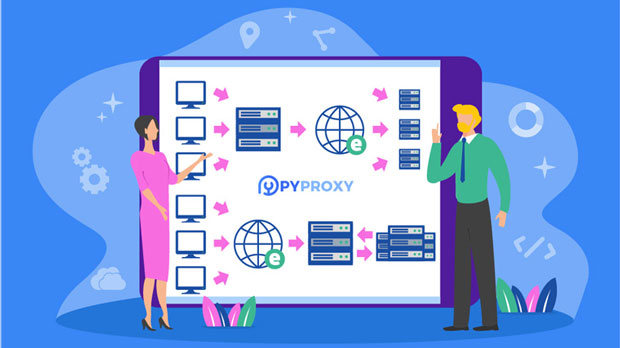When using proxy services like PYPROXY, users may sometimes experience slower loading speeds on specific websites. This issue often raises questions regarding the effectiveness and speed of proxy networks. The reasons behind this can vary from network latency, geographical location, to the nature of the website being accessed. In some cases, websites employ techniques that deliberately slow down proxy users, while in other instances, the infrastructure or the connection between the proxy server and the target site may not be optimized for speed. This article will explore the underlying causes of slow loading speeds, diving into various technical and operational factors that affect the performance of proxy networks, and offering insights on how to address these challenges. Understanding the Factors That Affect Proxy PerformanceTo understand why PyProxy experiences slower speeds on certain websites, it's essential to first understand the multiple factors that can affect the performance of a proxy network. These factors range from the infrastructure of the proxy server itself to external elements like the target website's server configuration. Here are the key factors:1. Server Location and Network LatencyOne of the most significant reasons for slower loading times is the geographical location of the proxy server. When a proxy server is far away from the user or the target website’s server, the data has to travel a longer distance, increasing the time it takes to fetch the requested data. This latency can be particularly noticeable on websites that have heavy multimedia content or require complex data processing.Network latency is the time delay between sending a request and receiving a response. If the proxy server is located in a distant region or operates through congested network routes, the delay can significantly impact browsing speed. Additionally, proxies that route through multiple servers or require extra hops before reaching the destination can increase latency, making websites load slower.2. Website-Specific Anti-Proxy MeasuresMany websites implement anti-proxy measures to detect and slow down or block proxy users. These websites do this to prevent unauthorized access, avoid scraping, or mitigate security risks. Techniques such as rate limiting, CAPTCHA systems, and IP blocking are commonly used to prevent proxy users from accessing the content at normal speeds.When a proxy server is used, websites may detect multiple requests originating from the same IP address or recognize unusual browsing patterns, triggering security mechanisms that slow down the loading time or block access altogether. In some cases, proxy services may attempt to mask these activities, but sophisticated detection systems can still find ways to throttle the connection, leading to slower speeds.3. Proxy Server Load and CapacityThe performance of a proxy server is also heavily dependent on its load and capacity. If a proxy server is handling a large number of users simultaneously, its ability to process requests quickly can be compromised. High server loads can lead to increased response times, delays in fetching data, and a reduction in browsing speed.Additionally, the hardware resources of the proxy server, such as CPU processing power and available bandwidth, play a crucial role in maintaining fast speeds. If the server’s hardware is outdated or insufficient for the volume of traffic it handles, it will struggle to provide fast connections, resulting in slower performance for users.4. Target Website’s Server PerformanceWhile the proxy server may be functioning optimally, the website itself may have performance issues that contribute to slow loading times. Websites with poorly optimized servers, excessive traffic, or outdated infrastructure may struggle to handle the influx of requests from proxy users, which can result in slower loading times.If a website uses heavy scripts, large media files, or poorly optimized code, these factors can amplify the effects of using a proxy. For instance, the proxy may have to handle more data than a typical direct connection, resulting in longer processing times.5. Bandwidth Limitations and ThrottlingBandwidth plays a crucial role in determining how fast data can be transferred between the proxy server and the target website. Proxy services may impose bandwidth limits or throttling to manage the load across users and ensure fair usage. If a user exceeds their allocated bandwidth or the proxy server is under heavy traffic, the connection speed will naturally slow down.Throttling is often used to prevent overloading the proxy server, but it can result in slower speeds for users. Websites with heavy traffic, particularly during peak times, may also experience bandwidth congestion, leading to slower loading speeds for everyone accessing the site, including proxy users.6. Use of HTTPS and Encryption OverheadsEncryption plays a vital role in securing data transmitted through proxies, especially when accessing websites that use HTTPS. However, the encryption process adds overhead to the connection. When data is encrypted and decrypted at both ends of the proxy network, it consumes additional processing power and time.While HTTPS encryption is necessary for security, it can also lead to slower loading speeds due to the additional steps required to establish a secure connection. This effect can be particularly noticeable when using proxies that need to handle a large volume of encrypted traffic.7. Proxy Type: Residential vs. Data Center ProxiesThere are different types of proxies, such as residential proxies and data center proxies, each with its advantages and disadvantages. Residential proxies tend to have a better reputation for avoiding detection and blocking but may suffer from slower speeds due to shared usage on residential IPs. Data center proxies, on the other hand, can offer faster speeds due to dedicated bandwidth but may be easier to detect and block by sophisticated websites.Choosing the right proxy type based on the user’s needs and the type of website being accessed is essential. For example, if speed is the primary concern, a data center proxy might be a better choice for websites that don’t have strict anti-proxy measures.8. Internet Connection QualityWhile proxies are a significant factor in determining browsing speeds, it’s essential not to overlook the quality of the user’s internet connection. Slow or unstable internet connections will exacerbate latency and reduce overall browsing speeds. Even the fastest proxy server can’t overcome poor connection quality on the user’s end.Users should ensure that their internet connection is stable, fast, and capable of supporting the required bandwidth for proxy browsing. Upgrading to a better internet plan or ensuring that no other devices are hogging bandwidth can help improve overall proxy performance.Conclusion: Maximizing Proxy Speed for Better PerformanceIn summary, slow loading speeds when using PyProxy or any other proxy service can be attributed to several factors. These include network latency, server load, website-specific anti-proxy measures, bandwidth limitations, and the type of proxy being used. Understanding the relationship between these factors and optimizing the proxy setup can significantly improve browsing speeds.To enhance the performance of proxies, users should choose proxies that align with their needs, ensure they use fast and stable internet connections, and be aware of potential issues like high server load or website-specific restrictions. By addressing these elements, users can maximize the speed and efficiency of their proxy network and enjoy faster browsing experiences across different websites.
Apr 03, 2025
![arrow]()



























































